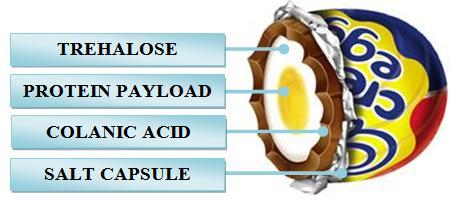Team:Imperial College London/M2
From 2009.igem.org
(→Module 2 Part i: Encapsulation) |
JamesField (Talk | contribs) (→Overview) |
||
| Line 2: | Line 2: | ||
==Overview== | ==Overview== | ||
| + | |||
| + | |||
| + | <b>WHAT</b> | ||
| + | |||
| + | Module 2 is a distinct stage that involves the production of an extracellular protective polysaccharide (colanic acid), acid resistance proteins, and storage metabolites. | ||
| + | |||
| + | |||
| + | <b>WHEN</b> | ||
| + | |||
| + | Module 2 is initiated following the completion of protein production (Module 1) and prior to genomic neutralisation (Module 3). It should be noted that Module 1 protein production will continue throughout Module 2 but at a heavily reduced rate such that additional resources can be devoted to Module 2 activity. | ||
| + | |||
| + | |||
| + | <b>WHY</b> | ||
| + | |||
| + | Product storage is an important requirement of our system. To achieve this, trehalose is produced during Module 2 to help maintain structural integrety during the freeze drying process. Trehalose additionally, protects the internal 'protein payload' from free radical attack. | ||
| + | |||
| + | |||
| + | |||
| + | |||
| + | |||
| + | |||
| + | |||
Module 2 of our system consists of 2 parts: <br> | Module 2 of our system consists of 2 parts: <br> | ||
i) An encapsulation mechanism - through which our cells secrete an exopolysaccharide capsule, to protect the cell from the harsh conditions encountered in the stomach.<br> | i) An encapsulation mechanism - through which our cells secrete an exopolysaccharide capsule, to protect the cell from the harsh conditions encountered in the stomach.<br> | ||
Revision as of 17:06, 1 September 2009

Contents |
Overview
WHAT
Module 2 is a distinct stage that involves the production of an extracellular protective polysaccharide (colanic acid), acid resistance proteins, and storage metabolites.
WHEN
Module 2 is initiated following the completion of protein production (Module 1) and prior to genomic neutralisation (Module 3). It should be noted that Module 1 protein production will continue throughout Module 2 but at a heavily reduced rate such that additional resources can be devoted to Module 2 activity.
WHY
Product storage is an important requirement of our system. To achieve this, trehalose is produced during Module 2 to help maintain structural integrety during the freeze drying process. Trehalose additionally, protects the internal 'protein payload' from free radical attack.
Module 2 of our system consists of 2 parts:
i) An encapsulation mechanism - through which our cells secrete an exopolysaccharide capsule, to protect the cell from the harsh conditions encountered in the stomach.
ii) A storage mechanism - through which a disaccharide (trehalose) is produced within the cell, with the intention of conferring our protein of interest with some resistance to cold shock and dessication.
Module 2 Part i: Encapsulation
In order to deliver our protein of interest to the gut, we must find some way of conferring our cells with some ability to withstand the harsh conditions present within the stomach.
Escheria coli naturally has a mechanism for withstanding these conditions, allowing them to survive through to the gut. This mechanism consists of secretion of a 'slime capsule,' which allows the cells to resist the highly acidic environment of the stomach. This 'slime capsule' mainly consists of secreted exopolysaccharides, such as colanic acid. By upregulating these genes that are naturally present, this will give our cells the ability to 'auto-encapsulate' - to secrete this slime capsule when required, and allowing our cells to bypass the stomach.
There are several genes required for synthesis of colanic acid.
RcsB, WaaL, B3023
This image shows a cross section of our cells, consisting of our protein of interest within, surrounded by ...
RcsB
RcsB upregulates the following genes:
ivy (Inhibitor of Vertebrate lysozyme)
- Discovered in 2001 as the first bacterial lysozyme inhibitor. This Type-C lysozyme inhibitor resides in the periplasm.1
MilC (Membrane-bound lysozyme inhibitor of Type C lysozyme)
- This is a lipoprotein that resides in the membrane. 1
References
- [http://www.ncbi.nlm.nih.gov/pubmed/19136591 The Rcs two-component system regulates expression of lysozyme inhibitors and is induced by exposure to lysozyme]
RcsB downregulates the following genes:
Module 2 Part ii: Trehalose Production
An important consideration when designing the specifications of the E.ncapsulator was the ability to store the cells for extended periods of time. This could be achieved by dehydrating the cells. However, normally under such conditions there poses a problem to maintaining the integrity of the proteins within the cells. This is problematic for us, as this could lead to breakdown of our protein of interest.
In order to preserve the integrity of our protein of interest during storage of the E.ncapsulator, we decided to incorporate a device for trehalose production within our system. Trehalose is a disaccharide formed from two glucose molecules. Throughout nature, trehalose is associated with resistance to dessication and cold shock, and is naturally produced in Escherichia Coli. We hope that by upregulating the trehalose production pathways in E.coli we can increase trehalose concentrations within our cell, thereby conferring some resistance to protein degredation in our system. This would allow easy transport and storage of the final product.
The trehalose coding region in E.coli consists of 2 genes, OtsA and OtsB - each coding for a different enzyme required for the conversion of glucose to trehalose.
 "
"




